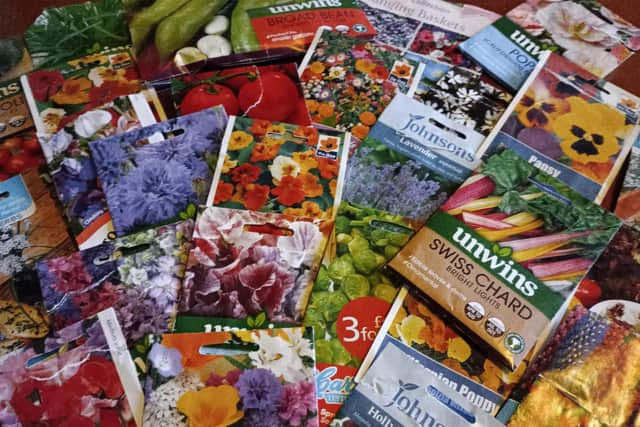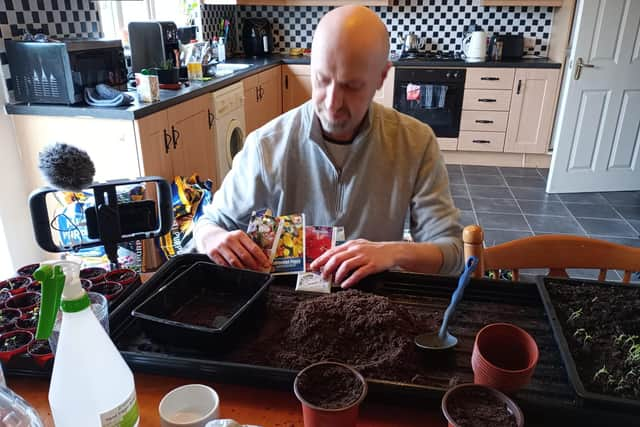Gone to Seed: Gardening with Brendan Week 2 - Lavender cold stratification and sowing hollyhock and Californian poppy seeds
and live on Freeview channel 276
The sunny days have been fertile ground for helping bring on and germinate a lot of the seeds I planted over recent weeks, with the heat and sun loving tomatoes showing the most progress.
It's too cold and conditions too variable to start hardening off most plants for a while yet, but after a month of slow progress, I transplanted the cherry tomato and Moneymaker tomato seedlings into larger pots and left them to soak up the sunshine on windowsills and they have come on very well.
Advertisement
Hide AdAdvertisement
Hide AdWhile most people will be growing tomatoes mainly for fruit, I'm also growing them for the strong, aromatic scent the plants give off in summer. In fact the fragrant foliage of the tomato plant has been used for centuries in perfumery, in everything from eau de cologne and soaps to scented candles and if you rub a tomato leaf between your fingers and have a sniff you'll see why.


The trick with tomatoes is to plant them early - February or March is best - and keep them somewhere warm where they can get plenty of light.
In the long grass
You could probably count on your fingers the number of dry days over the past six months, and combined with a relatively mild winter that has left my garden, and I'm sure many of yours, in a right state. The grass has been so sodden it has been impossible to cut it but after a few dry days in March I was finally able to get the lawnmower out and plan to till part of it for planting out with some bags of topsoil and compost in among the garden soil. I won't be doing that for a good few weeks yet as there is still a high probability of some frosty nights which would kill off home grown seedlings. After so much rain, another major issue this spring and summer is likely to be slugs and snails as these have been ideal conditions for them to thrive and multiply. I'll be trying out a few non-lethal techniques later in the spring as slugs can be very beneficial for decomposing and fertilising the soil so I don't want to harm them.
New seeds planted and transplanting


I have to stop buying seeds, it's becoming a problem! I want to try everything all at once but it is a lot. This week I have sown more seeds, including red poppies and large rose coloured frilly poppies outdoors in a big pot and some hollyhock and yellow Californian poppies in a seed tray indoors as well as two more varieties of sweet pea. Some of the other sweet peas I planted last week are starting to emerge. I had also planted some lupin seeds after soaking them for 12 hours in a little dish of water and five have come up.
I have had these lupin seeds for quite a few years and used half the packet last year with no success so I didn't have any great expectations. The only thing I did differently this time was pre-soaking the seeds. I've also planted some nasturtium seeds so we'll see how they do.
Advertisement
Hide AdAdvertisement
Hide AdThe night scented phlox, Icelandic poppies have been transplanted into larger pots and the broccoli, baby's breath and godetia (clarkia), pin-striped marigolds are all ready to be transplanted from their seed trays into larger pot. I've had good success with seeds planted recently with around 60 giant Swiss pansies germinated so far, hundreds of tiny trailing lobelia are up and a few miniscule petunia seedlings - a mixed variety and a stunning night sky dark blue with white speckles - are also starting to poke through the soil. I've also planted a blackcurrant bush in normal compost and bought a bag of erricaceous soil for an acidic soil loving blueberry bush and both are in pots outside. I bought the two tiny dry rooted bushes for £2.50 each at a local shop. The blueberry bush looked dead or dormant so we'll see if any buds come over the coming weeks, but the blackcurrant is already sprouting new growth.
But it hasn't been all good. The larkspur have not been doing well since they were transplanted and many have just keeled over and died. A lot of seedings suffer from transplant shock so it would probably have been better to direct sow them, though they may not have survived the slugs anyway. There are still around a dozen or so still standing. There's also no sign of the sunflowers or the decade old herb seeds taking root.
Cold stratification
This process mimics winter conditions, as if a seed were laying in the cold ground in nature and it is designed to wake them up. It’s is handy for perennial flowers, strawberries and some vegetables that come back every year but isn’t needed for annual plants. For the cold stratification, you take a piece of kitchen roll and lay it flat and spray it with water until it is damp but not soaking (let the water creep up towards the edges of the paper). Scatter your seeds onto the damp paper towel, and place another piece of kitchen roll over the top of them. Give a few more spritzes if necessary and press gently so the seeds have contact with the damp paper on both sides. Now take a ziplock bag like the one you use for toiletries at airport security or for sandwiches etc, or a plastic container / tuperware and carefully lift the kitchen towels with the seeds inside into the bag flat (you can fold in two if the bag is smaller that the paper towels). And then just seal it up and leave them in the fridge for around three weeks. This can vastly improve germination rates for difficult to grow perennials. After a few weeks take them out and plant them in seed trays and pots.
I'm really hoping the lavender come on as I want to create a barrier with a row of them outdoors to help deter slugs as they tend to stay away from strong smelling plants and herbs and won't eat them, and also for the scent. I might even try to make some jam from the currants and lavender flowers (which are edible) if they do survive.
New seeds I've picked up include oxeye daisy, German chamomile and lunaria (also known as 'honesty', 'silver pennies' or 'silver dollars').
Lunaria with their round, pan like iridescent paper seed pods which are used in dry flower arranging and which came in autumn after the plant produces really nice purple flowers on silvery foliage. The lunaria were a garden favourite in the 70s and 80s but you rarely see them now. They are a biennial so they may not flower till next year but I'll start them and see.
Till next week!